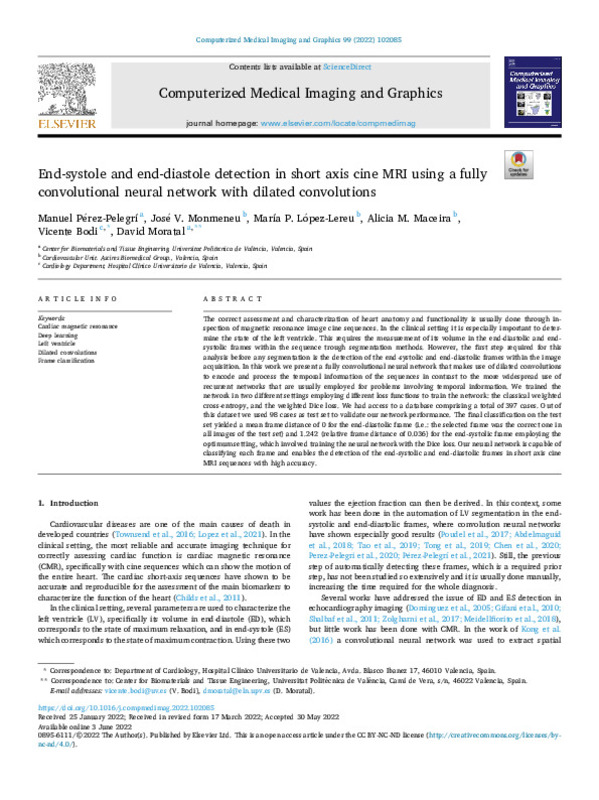JavaScript is disabled for your browser. Some features of this site may not work without it.
Buscar en RiuNet
Listar
Mi cuenta
Estadísticas
Ayuda RiuNet
Admin. UPV
End-systole and end-diastole detection in short axis cine MRI using a fully convolutional neural network with dilated convolutions
Mostrar el registro sencillo del ítem
Ficheros en el ítem
| dc.contributor.author | Pérez-Pelegrí, Manuel
|
es_ES |
| dc.contributor.author | Monmeneu, José V.
|
es_ES |
| dc.contributor.author | López-Lereu, María P.
|
es_ES |
| dc.contributor.author | Maceira, Alicia M.
|
es_ES |
| dc.contributor.author | Bodi, Vicente
|
es_ES |
| dc.contributor.author | Moratal, David
|
es_ES |
| dc.date.accessioned | 2023-10-04T18:01:55Z | |
| dc.date.available | 2023-10-04T18:01:55Z | |
| dc.date.issued | 2022-07 | es_ES |
| dc.identifier.issn | 0895-6111 | es_ES |
| dc.identifier.uri | http://hdl.handle.net/10251/197574 | |
| dc.description.abstract | [EN] The correct assessment and characterization of heart anatomy and functionality is usually done through inspection of magnetic resonance image cine sequences. In the clinical setting it is especially important to determine the state of the left ventricle. This requires the measurement of its volume in the end-diastolic and end-systolic frames within the sequence trough segmentation methods. However, the first step required for this analysis before any segmentation is the detection of the end-systolic and end-diastolic frames within the image acquisition. In this work we present a fully convolutional neural network that makes use of dilated convolutions to encode and process the temporal information of the sequences in contrast to the more widespread use of recurrent networks that are usually employed for problems involving temporal information. We trained the network in two different settings employing different loss functions to train the network: the classical weighted cross-entropy, and the weighted Dice loss. We had access to a database comprising a total of 397 cases. Out of this dataset we used 98 cases as test set to validate our network performance. The final classification on the test set yielded a mean frame distance of 0 for the end-diastolic frame (i.e.: the selected frame was the correct one in all images of the test set) and 1.242 (relative frame distance of 0.036) for the end-systolic frame employing the optimum setting, which involved training the neural network with the Dice loss. Our neural network is capable of classifying each frame and enables the detection of the end-systolic and end-diastolic frames in short axis cine MRI sequences with high accuracy. | es_ES |
| dc.description.sponsorship | Funding sources This work was partially supported by the Conselleria d'Innovació, Universitats, Ciència i Societat Digital, Generalitat Valenciana (grants AEST/2020/029 and AEST/2021/050) . | es_ES |
| dc.language | Inglés | es_ES |
| dc.publisher | Elsevier | es_ES |
| dc.relation.ispartof | Computerized Medical Imaging and Graphics | es_ES |
| dc.rights | Reconocimiento - No comercial - Sin obra derivada (by-nc-nd) | es_ES |
| dc.subject | Cardiac magnetic resonance | es_ES |
| dc.subject | Deep learning | es_ES |
| dc.subject | Left ventricle | es_ES |
| dc.subject | Dilated convolutions | es_ES |
| dc.subject | Frame classification | es_ES |
| dc.subject.classification | TECNOLOGIA ELECTRONICA | es_ES |
| dc.title | End-systole and end-diastole detection in short axis cine MRI using a fully convolutional neural network with dilated convolutions | es_ES |
| dc.type | Artículo | es_ES |
| dc.identifier.doi | 10.1016/j.compmedimag.2022.102085 | es_ES |
| dc.relation.projectID | info:eu-repo/grantAgreement/GENERALITAT VALENCIANA//AEST%2F2020%2F029//Aplicación de técnicas de deep learning (aprendizaje profundo) para un análisis automático de imágenes de Resonancia Magnética cardiaca/ | es_ES |
| dc.relation.projectID | info:eu-repo/grantAgreement/GENERALITAT VALENCIANA//AEST%2F2021%2F050//ESTABLECIMIENTO DE UN BIOMARCADOR PREDICTOR DEL RIESGO DE.../ | es_ES |
| dc.rights.accessRights | Abierto | es_ES |
| dc.contributor.affiliation | Universitat Politècnica de València. Escuela Técnica Superior de Ingenieros Industriales - Escola Tècnica Superior d'Enginyers Industrials | es_ES |
| dc.description.bibliographicCitation | Pérez-Pelegrí, M.; Monmeneu, JV.; López-Lereu, MP.; Maceira, AM.; Bodi, V.; Moratal, D. (2022). End-systole and end-diastole detection in short axis cine MRI using a fully convolutional neural network with dilated convolutions. Computerized Medical Imaging and Graphics. 99:1-8. https://doi.org/10.1016/j.compmedimag.2022.102085 | es_ES |
| dc.description.accrualMethod | S | es_ES |
| dc.relation.publisherversion | https://doi.org/10.1016/j.compmedimag.2022.102085 | es_ES |
| dc.description.upvformatpinicio | 1 | es_ES |
| dc.description.upvformatpfin | 8 | es_ES |
| dc.type.version | info:eu-repo/semantics/publishedVersion | es_ES |
| dc.description.volume | 99 | es_ES |
| dc.identifier.pmid | 35689982 | es_ES |
| dc.relation.pasarela | S\470300 | es_ES |
| dc.contributor.funder | GENERALITAT VALENCIANA | es_ES |
| dc.contributor.funder | Universitat Politècnica de València | es_ES |
| dc.subject.ods | 03.- Garantizar una vida saludable y promover el bienestar para todos y todas en todas las edades | es_ES |








